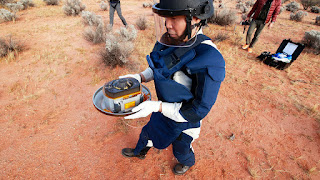Japan's Hayabusa2 case lands with carbon-rich space rock tests
Japan's Hayabusa2 case lands with carbon-rich space rock tests
Japan has indeed recovered examples from a removed space rock, which researchers will examine for signs about the old conveyance of water and natural atoms to Earth. The return case of the Hayabusa2 mission—about the size and state of a wok—dropped to an arrival in the red desert sand of Woomera, Australia, in the early morning of 6 December, after an almost 5.3-billion-kilometer excursion to the space rock Ryugu. A helicopter group homed in on a radio signal and found the case flawless.
Dispatched in 2014 by the Institute of Space and Astronautical Science of the Japan Aerospace Exploration Agency (JAXA), Hayabusa2 went through year and a half surrounding Ryugu, mentioning far off objective facts of the jewel formed rubble heap. It likewise delivered a few little meanderers that bounced on a superficial level social affair information. Subsequent to recognizing safe spots in the midst of the rocks, the specialty made two brief scores to snatch tests, once from the surface and again in the wake of shooting a cavity to uncover subsurface materials. The objective was to gather 100 milligrams of carbon-rich soil and rock pieces. Exactly how much material was gathered won't be known until the example compartment—the "treasure box"— is opened in tidy up room offices in Tokyo this week. In any case, by examining recordings of the example assortment, "we accept that a great deal of material was gathered," JAXA Mission Manager Makoto Yoshikawa said in an ongoing instructions.
In 2010, the first Hayabusa mission turned into the first to restore material from a space rock to Earth, after a visit to the space rock Itokawa. Planetary researchers are keen on space rocks since they hold early stage material present during the development of the Solar System 4.6 billion years prior that was not adjusted by the warmth and weights of cycles on planets. Ryugu is a carbonaceous, or C-type, space rock, which are thought to contain both natural materials and hydrates—minerals wealthy in synthetically bound water. At the point when comparative space rocks pounded a proto-Earth billions of years back, they may have helped launch life by conveying the structure blocks, Yoshikawa said. "It very well may be that these natural materials were the wellsprings of life on Earth."
Distant perceptions of Ryugu as of now designate "that water-bearing minerals are pervasive," and that the surface holds a "lot of natural materials," says Sei-ichiro Watanabe, a planetary researcher at Nagoya University and Hayabusa2 venture researcher. Examinations in earthbound labs will recognize the hydrated minerals and natural particles, giving pieces of information with regards to when and how they were framed.
Seiji Sugita, a planetary researcher at the University of Tokyo, says deciding the plenitude of water in Ryugu will help decide how much water space rocks conveyed to Earth billions of years back. Be that as it may, there is a riddle: Ryugu seems to convey far less water than the generally comparable space rock Bennu, which is the objective of a NASA test bring mission back. "We have several promising speculations on why and how Ryugu or its parent body lost or neglected to pick up water," says Sugita, a Hayabusa2 colleague. "Yet, we need an unmistakable answer from test investigation."
Concerning the inception of life, there is little help for the possibility that space rocks really cultivated life itself, says Jonti Horner, an astrobiologist at the University of Southern Queensland, Toowoomba, who isn't associated with the Hayabusa2 mission. Be that as it may, carbon-rich shooting stars, hailing from space rocks like Ryugu, show science on these early stage bodies may create amino acids and even RNA—which might have given prebiotic science on antiquated Earth a lift. "That is the reason individuals are keen on taking a gander at what the crude material on space rocks like Ryugu really contains," Horner says. Be that as it may, recognizing biomolecules because of natural defilement from unblemished organics in the space rock tests is "extremely troublesome," Sugita says. "The Ryugu tests brought by Hayabusa2 are as Earth-pollution free as it can get," he says.
Subsequent to delivering the example return container into Earth's gravitational handle, Hayabusa2 skirted away and will proceed to a 2031 meeting with the space rock 1998 KY26. Mission organizers concluded it was the most deductively fascinating space rock Hayabusa2 could reach and study, given excess fuel, Yoshikawa said. The small 30-to 40-meter-breadth body seems to pivot once like clockwork.
In the interim, NASA'S OSIRIS-REx mission is because of return tests from space rock Bennu in September 2023. JAXA and NASA have consented to trade tests from their particular missions. Along with the Itokawa tests, analysts will have the option to analyze tests from three space rocks. "We'll have the option to get familiar with significantly more about the Solar System's past than we actually could by visiting one of them," Horner says. "It will be a truly intriguing few years as we see the outcomes these missions yield."







0 comments:
Post a Comment
If you have any doubt, Please comment here.